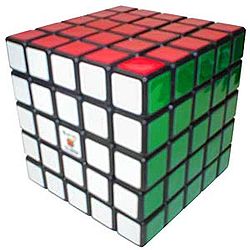Professor's Cube: Difference between revisions
perhaps my RV is a candidate for the bad jokes ... |
|||
| Line 24: | Line 24: | ||
:<math> \frac{8! \cdot 3^7 \cdot 12! \cdot 2^{10} \cdot 24!^3}{4!^{12}} \approx 2.8 \cdot 10^{74}</math> |
:<math> \frac{8! \cdot 3^7 \cdot 12! \cdot 2^{10} \cdot 24!^3}{4!^{12}} \approx 2.8 \cdot 10^{74}</math> |
||
The full number is precisely 282,870,942,277,741,856,536,180,333,107,150,328,293,127,731,985,672,134,721,536,000,000,000,000,000 possible permutations (about 283 trevigintillion on the short scale). |
The full number is precisely 282,870,942,277,741,856,536,180,333,107,150,328,293,127,731,985,672,134,721,536,000,000,000,000,000 possible permutations (about 283 trevigintillion on the short scale). |
||
===Durability=== |
===Durability=== |
||
Revision as of 19:32, 6 March 2008

The Professor's Cube (also known as Rubik's Professor) is a mechanical puzzle invented by Udo Krell. It is a 5×5×5 version of the Rubik's Cube. It has qualities in common with both the original 3×3×3 Rubik's Cube and the 4×4×4 Rubik's Revenge, and knowing the solution to either can help when working on the 5×5×5 cube.
Naming
Early versions of the 5×5×5 cube sold at Barnes and Noble were marketed under the name "Professor's Cube," but currently, Barnes and Noble sells cubes that are simply called "5×5×5." Mefferts.com offers a limited edition version of the 5×5×5 cube that is identified as the Professor's Cube. This version has colored blocks rather than stickers.
Workings
The Professor's Cube works by using an expanded 3×3×3 cube as a mantle with the center edge pieces and corners sticking out from the spherical center of identical mechanism to the 3×3×3 cube. The non central center pieces are fitted into spaces on the surface of the 3×3×3 mantle, and the non central edges slotted between them. All non-central pieces have extensions that fit into alloted spaces on the outer pieces of the 3×3×3, which keeps them from falling out of the cube while making a turn.
Permutations

There are 8 corner cubelets, 36 edge cubelets (two types), and 54 center cubelets (48 movable of two types, 6 fixed).
Any permutation of the corner cubelets is possible, including odd permutations, giving 8! (40,320) possible arrangements. Seven of the corner cubelets can be independently rotated, and the eighth cubelet's orientation depends on the other seven, giving 37 combinations.
Assuming the 4 center cubelets of each type of each colour are indistinguishable, there are (24!/(4!6))² or 24!²/4!12 arrangements, all of which are possible, independently of the corner cubelets.
Identically coloured pairs among the 24 outer edge cubelets cannot be flipped. The two cubelets in each matching pair are distinguishable, since the colours on a cubelet are reversed relative to the other. Any permutation of the outer edge cubelets is possible, including odd permutations, giving 24! arrangements, independently of the corner cubelets and indistinguishable center cubelets. The 12 central edge cubelets can be flipped. Eleven can be flipped and arranged independently, giving 12!/2 × 211 or 12! × 210 possibilities (an odd permutation of the corner cubelets implies an odd permutation of the central edge cubelets, and vice versa, thus the division by 2). Counting the outer edge cubelets, there are 24! × 12! × 210 possibilities.

The corner, central edge and fixed center cubelets together form a 3×3×3 Rubik's Cube. In the case that centers of the same color are indistinguishable from each other the remaining cubelets can be arranged independently of it.
This gives a total number of permutations of
The full number is precisely 282,870,942,277,741,856,536,180,333,107,150,328,293,127,731,985,672,134,721,536,000,000,000,000,000 possible permutations (about 283 trevigintillion on the short scale).
Durability
The Professor's Cube is inherently more delicate than the 3×3×3 Rubik's Cube due to the considerable additional movable parts. It is not recommended that it be used for speedcubing. The puzzle should not be excessively forced to twist and it must be aligned properly before twisting to prevent damage. It is far more likely to break due to twisting misaligned rows. If twisted while not fully aligned, it may cause the pieces diagonal to the corners to almost fully come out. It is simply fixed by turning the face back to where it was, causing the piece to go back to its original position. Excessive force may cause the colored tile to break off completely. In such a case, the cubelet will stay in place, yet the color would be gone.
Solution
People able to rapidly solve puzzles like this usually favor the strategy of grouping similar edge pieces into solid strips, and centers into one-colored blocks. This allows the cube to be quickly solved with the same methods one would use for a 3×3×3 cube.
Another frequently used strategy is to solve the edges of the cube first. The corners can be placed just as they are in any previous order of cube puzzle, and the centers are manipulated with an algorithm similar to the one used in the 4×4×4 cube.
Records
The current record for solving the Professor's Cube in an official competition is 1:30.03, set by Erik Akkersdij from Netherlands[1] at the Swedish Cube Day 2007. Erik Akkersdijk[2] holds the record of 1:36.71 for the mean of five solves, set at the Swedish Cube Day competition 2007.
See also
- Pocket Cube – A 2×2×2 version of the puzzle also known as "ice cube"
- Rubik's Cube – The original 3×3×3 version of this puzzle
- Rubik's Revenge – A 4×4×4 version of the puzzle
- Combination puzzles
References
External links
- How to solve Professor's Cube
- Professor's Cube text solution
- Professor's Cube interactive solution
- Courtney McFarren's Professor's Cube solution

